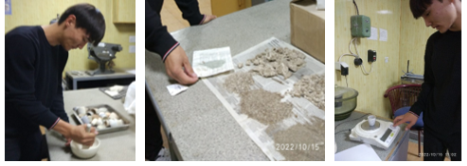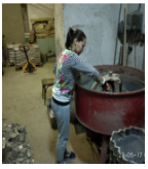The article provides information about the negative impact of technogenic waste on the environment and efficiency of manufacturing building materials from them, which are necessary in the rapidly developing construction industry.
Keywords: technogenic waste, environmental impact, environment, recycling, recycling, building materials, efficiency, environmental safety.
В статье приведены сведения о негативном влиянии техногенных отходов на окружающую среду и эффективности производства из них строительных материалов, необходимых в бурно развивающейся строительной отрасли.
Ключевые слова: техногенные отходы, воздействие на окружающую среду, окружающая среда, утилизация, утилизация, строительные материалы, эффективность, экологическая безопасность.
Introduction. In recent decades, transition to «green» economy, i.e. efficient use of natural resources and improving the well-being of citizens of Kazakhstan through economy diversification and creation of new jobs, improving living conditions for our citizens took particular significance in many countries of the world, including Kazakhstan
On the territory of the Republic, according to the State Cadastre, in dumps, tailings and storage facilities of mining enterprises about 30 billion tons industrial waste are stored including: 72,5 % — waste overburden, 25, 7 % — enrichment tailings, 1,8 % — waste from metallurgical plants (table). With annual output of industrial waste of 1 billion tons, no more than 100 million tons are usefully consumed. The rest pollutes the environment gradually accumulating in it (Fig. 1) [1, 2].
Table 1
Concentration waste by regions of Kazakhstan
|
Regions |
Quantity |
Reserves, thousand tons |
Area, km 2 |
|
Akmola |
11 |
76834,50 |
12,30 |
|
Aktobe |
8 |
30675,30 |
6,30 |
|
Almaty |
5 |
47914,90 |
2,99 |
|
East Kazakhstan |
39 |
887914,57 |
19,57 |
|
Zhambul |
6 |
44188,93 |
1,58 |
|
Karaganda |
37 |
2809342,13 |
89,20 |
|
Kostanay |
4 |
611101,70 |
27,45 |
|
Pavlodar |
2 |
8770,86 |
1,23 |
|
South Kazakhstan |
5 |
142355,30 |
3,52 |

Fig. 1. General view of technogenic waste
According to the data of the State control and supervision over natural resources, share of consumed waste in the republic is 18–20 %. For example, in 2007, percentage of waste utilization was 16 %, in 2008–18,98 %, and in 2009. — 20 %. However, this indicator in the recent past in the industry of the former USSR was 29 %. It remains extremely low in comparison with world practice. In Western Europe (France, Germany, Italy, England), this figure is up to 58 %, in North America (USA, Canada) — up to 63 %, in Japan — up to 87 %, China — up to 37 % [3–5].
In addition, construction scale-up in Kazakhstan requires considerable amount of minerals for building materials industry. Intensification in this direction is associated with use of industrial waste instead of primary natural resources to reduce cost of building materials. Use of mining solid waste in the building materials industry is cost-effective than production of building materials based on the special extraction of mineral raw materials.
Results. Relevance of development of technogenic mineral formations is dictated by fact that they occupy vast territories, easily blown off material is source of increased environmental risk for regions of mining and metallurgical complex. Constant increase in the volumes of various types of waste generated in the mining and processing industries and their storage in storage facilities and experience of using such facilities in industry allows us to consider them as sources for obtaining secondary raw materials and building materials
Purpose of this work , carried out by Mining and Metallurgical Institute of Satbayev University, is to consider the possibility of сompehensive use of technogenic waste in the areas of their disposal.
One of the enterprises where non-metallic rocks, enrichment tailings are formed and where research works is currently being carried out is Akshatau Mining and Processing Plant JSC, which receives feedstock from the Akzhal mine.
Survey results of workings at the Akzhal mine (in the quarry and underground horizons) showed that the largest number of fallouts is associated with fractured rocks, and the volume of the fallouts increases as the workings stand. Observations of workings passed through fractured rocks revealed that they are stable for a month. After two or three months, stabs up to 10–15 cm in size are formed. Stinging and falls develop within six months, the collapse of the roof occurs in the form of domes. This dramatically increases volume and labor intensity of tunneling operations, as well as the cost of fixing and repairing workings [6, 7].
To prevent collapse of workings passed through fractured rocks, anchor bolts with metal mesh and sprayed concrete are used. However, rocks exfoliation roof of transport drift and significant rocks destruction indicates that this support does not solve problem of ensuring stability of workings and does not prevent the development of deformations. As a result, after 2–3 years of standing workings, lining is destroyed and a major overhaul is required. Therefore, effective solution of fixing and controlling geomechanical properties of rocks is of particular importance for adjacent rock mass and for underground workings passed through fractured rocks.
One of the most common hardening methods is rock cementation. Rocks cementation in quarries begins from the upper platform of the ledge, where fans of vertical and inclined wells are drilled. Cement slurry is injected into them until massif is completely saturated [8]. In this regard, main characteristics of waste from the Akzhal concentrating plant were studied, from which it can be seen that they consist of calcite, therefore, reflections (peaks) characteristic of СаСО 3 are recorded on the X-ray pattern, with interplanar distances, d/n, Å: 3.8665; 3.3498; 3.0404; 2.8446; 2.496; 2.2847; 2.0952; 1.9127; 1.77; 1.6287; 1.60; 1.5236; 1.4393.
Chemical analysis showed that the waste rock mainly consists of, %: CaO — 54.6; CO 2 - 39.4; SO 3 - 2.0; MgO — 1.5; SiO 2 - 2.5 %; Fe [S 2 ] — about 0.18. Based on the results obtained, it can be stated that the non-metallic rock of the Akzhal deposit consists of limestone (СаСО 3 ) — about 95–97 % and silica (SiO 2 ) — about 2.5–3 %. Master and PhD students of KazNRTU named after K. I. Satpayev (Fig.2) are involved in this work [8].


Fig. 2. Laboratory research of industrial waste
Based on the results obtained, we have proposed a solution for strengthening fractured rocks containing filler, cement and process water. To reduce cost of solution as a filler, it was proposed to use tailings of concentrating plants.
The technical novelty of created solution was confirmed by the patents of the Republic of Kazakhstan for invention [9].
Discussion. Studies analysis carried out in underground workings also showed that the highest technological and technical and economic indicators of fixing mine workings by shotcrete method are achieved due to the correctly selected composition of concrete mixture, taking into account specifics of specific mining, technical, geological and hydrogeological conditions of workings. Therefore, we are currently working on a feasibility study for use of common and recommended new composition of shotcrete mortar.
Use of waste from mining and metallurgical complexes is one of the urgent problems not only in Kazakhstan, but in all countries with developed economies. Technogenic waste processing can become promising direction for business development in Kazakhstan for production of competitive building materials and make important contribution to improving environmental situation (Fig. 3).

Fig. 3. Building materials produced from MMC waste
Use of secondary raw materials will reduce need for primary mineral resources, there will be no need for specialized quarries for development of clays, sands, etc. that violate natural landscape.
Technologies development for production of building materials based on technogenic waste, contributing to the development of industrial and innovative potential of the state, respect for natural resources and environment, should be considered as the most important scientific and practical task, solution of which is directly related to environmental safety in the disposal of billions of tons of waste in industrial regions [10]. Economic efficiency of waste use is determined by the fact that technogenic raw materials have already been extracted from the bowels, crushed to a finely dispersed state and laid in dumps.
Conclusion
- Processing and utilization of MMC waste into building materials is aimed at solving environmental and social problems in regions with a developed mining and metallurgical industry.
- Rational organization of waste processing process, combined with efficient modern equipment, makes it possible to obtain products from secondary raw materials with a cost 2–2.5 times lower than for similar products from primary raw materials, with a comparable product quality.
Acknowledgments . Study was financially supported by the Science Committee of the Ministry of Science and Higher Education of the Republic of Kazakhstan (AP14871694).
References:
- Baijanov D. O., Bek A. A. «Green» economy in building materials // Mining Journal of Kazakhstan: 2020, No.7. — 45–48 p. http://minmag.kz/ru/2021/10/05/ %e2 %84 %967–2020/
- Information on waste management organization in the regions of the Republic of Kazakhstan.-Astana, 2019. — 154 p. http://ecogosfond.kz/wp-content/uploads/2019/11 /Informacionnyj-obzor-po-vedeniju-gosudarstvennogo-kadastra-othodov-za-2018_compressed.pdf.
- Melkonyan R. G. Environmental problems of mining waste disposal for glass production and construction industry. Bulletin of Science and Education of the North-West of Russia. 2017. Vol. 3. ISSN: 2413–9858 http://vestnik-nauki.ru/wp-content/uploads/2017/02/2017-No1Melkonyan.pdf
- Golik V. I., Tsidaev T. S. Methods of using tailings from processing substandard mineral raw materials. Stroitelnye materialy, oborudovanie, tekhnologii XXI veka. 2015. No. 12. 27–29 p.http://www.stroymat21.ru/arch.php?file_=./2012–12/newtxt.htm
- Lygina T. Z., Luzin V. P., Kornilov A. V., Multipurpose use of technogenic non-metallic raw materials and production of new types of products from it / Fort Dialog-Iset, Yekaterinburg. 2017, v.1, 67–71 p. ISBN: 978–5–91128–154–0https://www.elibrary.ru/item.asp?id=29734811&pff=1
- Nurpeisova M. B., Estemesov Z. A., Bekbasarov Sh.Sh. Processing of technogenic mineral formations is a promising niche for business.// Proceedings of the Research and Production Complex dedicated to the 115th anniversary of A.Zh.Mashanov and the 100th anniversary of Zh.S. Erzhanov «Innovative technologies in geospatial digital engineering» — Almaty: KazNITU6, 2022.- 191–197 p.
- Rysbekov К. Б., Nurpeisova M. B., Bek A. A. Use of enrichment waste for obtaining building materials// 4th International Scientific and Technical Internet Conference «Innovative development of resource-saving technologies and sustainable use of natural resources». Book of Abstracts. — Petroșani, Romania: UNIVERSITAS Publishing, 2021, 16–19 p. https://elprivod.nmu.org.ua/ua/articles/Ukraine_2021_Book_of_Abstracts.pdf
- Bek А. А., Yestemesov Z. А., Baidzhanov D. О., Fedotenko N. А. Effective strengthening solutions for fractured rock masses using tailings// Eurasian mining, 2022, No.1.59–64 p. (Scopus Q1). Процентиль 71 %.
- Utility model patent. No. 1573 RK. Composition for strengthening fractured rocks/ Nurpeisova M. B., Kyrgyzbaeva G. M., Bek A. A. https://kazpatent.kz/images/bulleten/2016/gazette /pdf/ 2–201608.pdf
- Kuldeev E. I., Nurpeisova M. B., Kyrgizbaeva G. M. Subsoil development and environmental safety. — Deutsschland LAP LAMBERT, 2021, 2021.-234 p.







